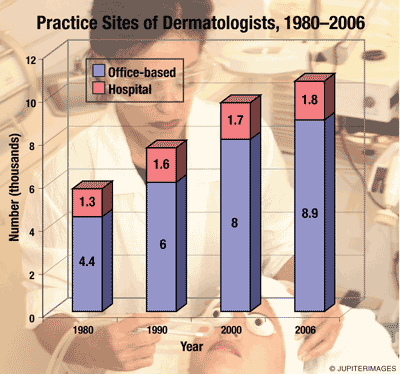US Pharm. 2009;34(4):10.
Ambulatory medical care in a physician's office is the largest and most widely used segment of the U.S. health care system, and in 2004 it comprised 25% of all health care spending. Physicians' offices accounted for 80% of all ambulatory medical care that was provided in 2006, and physician consultation services included everything from primary care to highly specialized surgical and medical care.
This report describes health care that was provided in the offices of non-federally employed dermatologists based on the interpretation of the National Ambulatory Medical Care Survey by the Centers for Disease Control and Prevention. The report includes not only visits to private practices, but also those to other settings, such as freestanding clinics. (This category includes urgent-care centers, public health clinics, and community health centers.)

Office Visits: Of the 902 million office visits that were made to all physicians during 2006, 4.2% of visits (37.4 million) were for the primary diagnosis and treatment of diseases of the skin and subcutaneous tissue. The annual rate of office visits made to dermatologists was 2.8% of all physician visits (i.e., 8.6 visits per 100 people), totaling 25.3 million patients. Of all visits by patients to primary care providers in 2006, 3.6% were made to dermatologists. Of visits that were made to dermatologists on a non-health care provider basis, 19% of patients were referred by other physicians, while 51.6% were not referred by other physicians. For 10 million people in 2006, skin rash was the primary reason for visiting the physician's office-based practice; this translates to 1.1% of all office visits made by women and 1.2% of all visits made by men. Patients spent an average of 17.5 minutes with the dermatologist.
Diagnosis and Treatment: In 2006, diagnostic or screening services were provided during 85.5% of all physician office visits. Of all the examinations that were performed as part of a diagnostic or screening service, examination of the skin topped the list with 12.6% of all visits. Women (accounting for 13.2% of visits) were more likely to have examinations of the skin compared with men, who accounted for 11.7% of visits. In 2006, drugs were prescribed by dermatologists during 17 million office visits (2.7% of all visits). During 68% of these visits, 37 million drugs (which accounted for 2% of all drug mentions) were prescribed. An average of 146 dermatologic agents were prescribed per 100 office visits, which gives this category a rank of 11 (with 53 million mentions) in the top 20 most frequently prescribed therapeutic categories.
To comment on this article, contact rdavidson@jobson.com.




